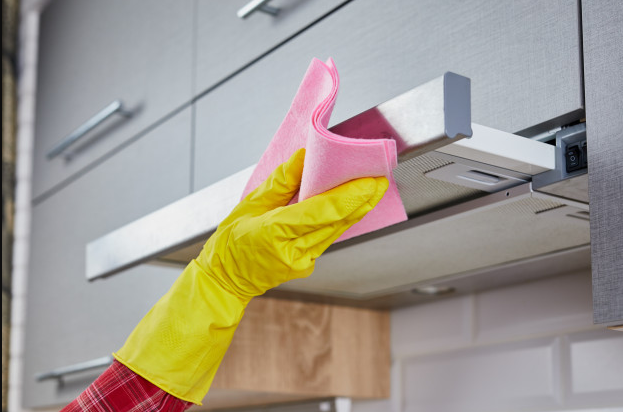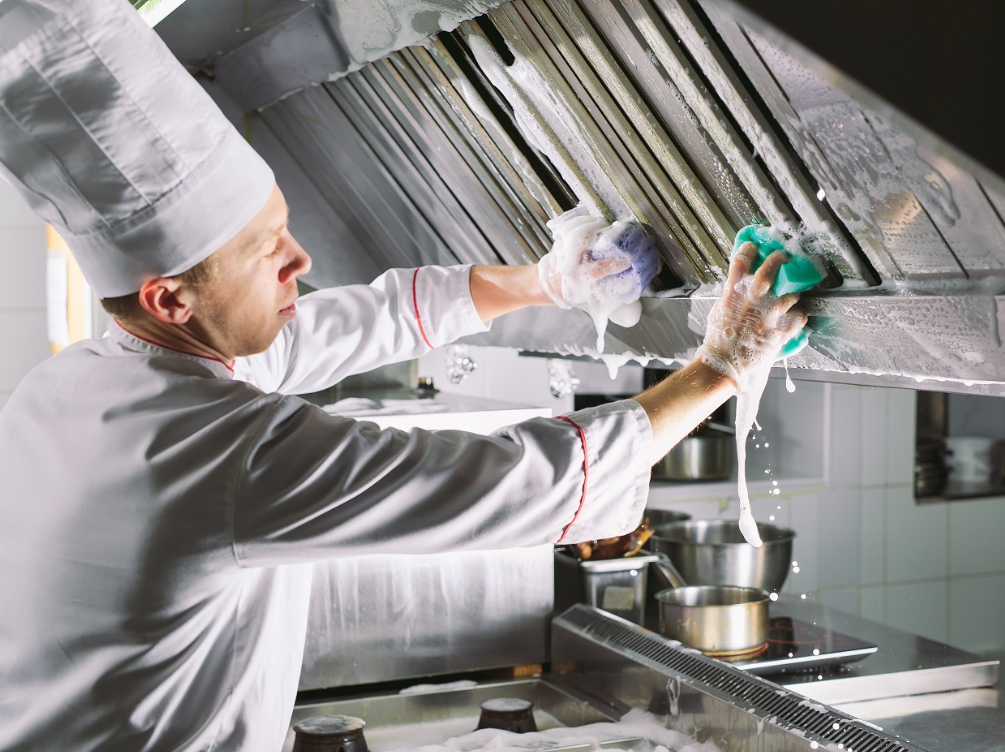Kitchen Hood Duct Cleaning is an essential maintenance task to ensure the safety and efficiency of your kitchen ventilation system. Proper cleaning of the ducts removes grease, debris, and other contaminants that can accumulate and pose fire hazards or hinder the functioning of the hood.
Neglecting this cleaning can lead to increased energy costs, decreased air quality, and even potential health risks. Regular cleaning by professionals is recommended to comply with safety regulations and maintain a clean and hygienic kitchen environment. When it comes to kitchen hood duct cleaning, it is crucial to prioritize it as part of your routine maintenance to prevent potential hazards and ensure optimal performance.
Neglecting this important task can lead to increased energy costs, decreased air quality, and potential health risks. By hiring professionals to clean your ducts, you can ensure compliance with safety regulations and maintain a clean and hygienic kitchen environment. So, don’t overlook the importance of kitchen hood duct cleaning and schedule regular cleanings to keep your kitchen running smoothly and safely.

The Importance Of Kitchen Hood Duct Cleaning
In today’s blog post, we will be discussing the importance of kitchen hood duct cleaning.
Health And Safety Concerns
Regular cleaning of kitchen hood ducts is essential for maintaining a healthy and safe cooking environment.
Kitchen hood ducts are designed to remove smoke, grease, and odors generated during cooking. Over time, these ducts can become clogged with grease, food particles, and other debris. This build-up not only reduces the efficiency of the exhaust system but also poses serious health risks.
When kitchen hood ducts are not cleaned regularly, they can become a breeding ground for bacteria, mold, and other contaminants. These pollutants can get circulated in the air, affecting the indoor air quality and posing a health risk to everyone in the vicinity. This is especially dangerous for individuals with respiratory conditions such as asthma or allergies.
To ensure a safe and healthy cooking environment, it is crucial to schedule regular kitchen hood duct cleaning.
Fire Hazard Prevention
One of the most significant risks associated with neglected kitchen hood ducts is the increased likelihood of a fire.
When kitchen hood ducts are clogged with grease and flammable particles, the risk of a fire rapidly escalates. Grease build-up from cooking processes can easily ignite, resulting in a potentially devastating fire in the kitchen.
The intense heat generated during a fire can cause the flames to quickly spread to other parts of the kitchen, putting everyone at risk. In worst-case scenarios, a kitchen fire can even result in property damage, injuries, or even fatalities.
Regular kitchen hood duct cleaning is crucial for preventing fire hazards and ensuring the safety of your home and everyone in it.
A professional cleaning service will thoroughly remove grease and other flammable substances from the ducts, reducing the risk of a fire breaking out. By eliminating this fire hazard, you can have peace of mind knowing that your kitchen is safe from potential disasters.
By prioritizing kitchen hood duct cleaning, you can create a healthier cooking environment and reduce the risk of fires. This preventive measure not only safeguards your health and safety but also protects your property from costly damage.
Signs Of A Dirty Kitchen Hood Duct
A dirty kitchen hood duct can lead to a range of issues, from reduced performance to unpleasant odors. If left unchecked, it can also pose a fire hazard. Knowing the signs of a dirty kitchen hood duct can help you take timely action and ensure a clean and safe kitchen environment. In this article, we discuss three common signs that indicate the need for kitchen hood duct cleaning.
Visible Grease Buildup
A telltale sign of a dirty kitchen hood duct is the presence of visible grease buildup. Over time, grease and oil particles accumulate inside the ductwork, coating it with a sticky residue. This buildup can be seen on the surface of the hood as well as the interior walls of the duct. Not only does the buildup look unappealing, but it also poses a significant fire risk. The grease is highly flammable and can easily ignite if exposed to a spark or high heat. Regular cleaning and maintenance can prevent the buildup and minimize the risk of fires.
Unpleasant Odors
Another sign that your kitchen hood duct needs cleaning is the presence of unpleasant odors. As grease accumulates in the duct, it can start to decompose, emitting foul smells that can quickly spread throughout your kitchen. These odors can be particularly noticeable when you turn on your hood exhaust fan or cook at high temperatures. Not only can these odors ruin the overall ambiance of your kitchen, but they can also affect the taste and quality of your food. By cleaning the duct regularly, you can eliminate the source of the odors and ensure your kitchen smells fresh and clean.
Reduced Hood Performance
A dirty kitchen hood duct can lead to reduced hood performance. As grease and debris accumulate in the duct, they restrict the airflow, diminishing the suction power of the exhaust fan. This reduced airflow can result in inadequate smoke and steam removal, leaving your kitchen filled with pollutants. Additionally, the buildup can cause the exhaust fan to work harder, leading to increased energy consumption and potentially shorter lifespan. By cleaning the duct regularly, you can restore the proper airflow and ensure optimal performance from your kitchen hood.
Professional Kitchen Hood Duct Cleaning Process
Keeping your kitchen hood and its ducts clean is vital for the safety and efficiency of your commercial kitchen. Not only does regular cleaning reduce the risk of fire hazards, but it also improves the air quality by removing grease and other pollutants. In this blog post, we will walk you through the professional kitchen hood duct cleaning process, which guarantees a thorough and effective cleaning. Let’s dive in!
Initial Inspection
The first step in the professional kitchen hood duct cleaning process is the initial inspection. A certified technician will thoroughly assess the condition of your kitchen hood and its ductwork to determine the extent of the cleaning required. This inspection helps identify areas of heavy grease buildup and any potential issues that need attention.
Degreasing And Cleaning
Once the initial inspection is completed, the next stage is degreasing and cleaning. This step involves the use of specialized techniques and cleaning agents to remove stubborn grease and grime from the kitchen hood and its ducts. The process usually starts with covering the cooking equipment and surrounding areas to protect them from any cleaning residue. Then, the technician will disassemble and clean all accessible parts of the kitchen hood, such as filters, grease cups, and baffles. High-pressure washing and manual scrubbing are often employed to ensure a thorough cleaning from top to bottom.
In addition to cleaning the visible parts of the kitchen hood, the technician will also focus on cleaning the ductwork. This involves using powerful equipment, such as rotary brushes and vacuums, to dislodge and remove grease buildup from the interior surfaces of the ducts. The cleaning process will continue until all traces of grease and contaminants are effectively removed, ensuring optimal air flow and fire safety.
Final Inspection And Certification
After the degreasing and cleaning process is completed, a final inspection is conducted to ensure that your kitchen hood and its ducts are clean and in proper working condition. The technician will check for any missed areas and perform a thorough evaluation to guarantee that your kitchen hood is free from grease buildup and potential fire hazards.
Once the inspection is successfully passed, you will be provided with a certification that verifies the cleanliness and compliance of your kitchen hood and ducts with industry standards and regulations. This certification not only showcases your commitment to kitchen safety but also provides peace of mind to stakeholders and authorities.
In conclusion, the professional kitchen hood duct cleaning process involves an initial inspection to assess the condition, followed by degreasing and cleaning of the hood and ducts, and finally, a thorough inspection and certification. By adhering to this process, you can ensure a clean, safe, and efficient kitchen environment for your staff and customers. Don’t underestimate the importance of regular kitchen hood duct cleaning to maintain optimal performance and comply with safety regulations.

Frequently Asked Questions For Kitchen Hood Duct Cleaning
How Often Should Kitchen Hood Duct Cleaning Be Done?
It is recommended to have your kitchen hood duct cleaning done at least once every 6 months to ensure optimal performance and safety.
What Are The Benefits Of Kitchen Hood Duct Cleaning?
Regular kitchen hood duct cleaning improves air quality, reduces fire hazards, increases energy efficiency, and extends the lifespan of your kitchen hood.
Why Is Professional Kitchen Hood Duct Cleaning Important?
Professional kitchen hood duct cleaning ensures thorough removal of grease, grime, and contaminants from the ducts, ensuring the safety of your kitchen and preventing potential fire hazards.
Can I Clean Kitchen Hood Ducts Myself?
While it is possible to clean kitchen hood ducts yourself, it is highly recommended to hire a professional service to ensure thorough cleaning and to avoid any potential damage to the ducts.
Conclusion
Regular kitchen hood duct cleaning is essential for maintaining a safe and healthy environment in your kitchen. Not only does it prevent the build-up of grease and other contaminants, but it also reduces the risk of fire hazards. By investing in this maintenance task, you can ensure the longevity and efficiency of your kitchen hood system.
Take the necessary steps to schedule regular cleanings and enjoy the benefits of a clean and functioning kitchen hood duct.
